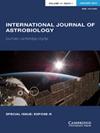从中国空间站组件洁净室表面分离并用16S rRNA/ITS测序和MALDI-TOF MS鉴定的耐酸铝微生物
IF 1
4区 物理与天体物理
Q3 ASTRONOMY & ASTROPHYSICS
引用次数: 1
摘要
铝(Al)的腐蚀是航天器的一个潜在问题,因为这种金属由于其强度、耐久性等原因被用于各种机械部件。然而,它会被某些因素腐蚀,包括微生物。由于微生物的嗜极性,研究微生物影响腐蚀(MIC)具有重要意义。在本研究中,从中国空间站组装洁净室表面样品中分离出铝和耐酸微生物;酸性环境会加速金属表面的腐蚀过程。采用16S核糖体RNA基因/内转录间隔区测序和基质辅助激光解吸/电离飞行时间质谱技术对9株细菌和10株真菌进行了鉴定。优势菌属为芽孢杆菌、青霉属真菌和曲霉属真菌。了解可能从洁净室输送到空间站的具有潜在Al降解能力的微生物对空间站部件的长期维护非常重要。本研究可能有助于设计上述微生物的进一步研究,从而有助于MIC的预防。本文章由计算机程序翻译,如有差异,请以英文原文为准。
Acid and aluminium-tolerant microbes isolated from China space station assembly cleanroom surfaces and identified by 16S rRNA/ITS sequencing and MALDI-TOF MS
Abstract Corrosion of aluminium (Al) is a potential problem for spacecraft as this metal is used for various mechanical parts due to its strength, durability, etc. However, it can be corroded by certain factors including microbes. Studying microbes which can be implicated in microbiologically influenced corrosion (MIC) due to their extremophilic nature is of vital importance. In this current study, Al and acid-tolerant microbes were isolated from the samples of China space station assembly cleanroom surfaces; acidic environments can accelerate the corrosion process on metal surfaces. Nine bacterial and 10 fungal strains were identified with 16S ribosomal RNA gene/internal transcribed spacer region sequencing and matrix-assisted laser desorption/ionization time-of-flight mass spectrometry. The dominant bacteria were of Bacillus, fungi of Penicillium and Aspergillus genera. Knowing the microbes which may be conveyed from the cleanrooms to the space stations with a potential capacity of Al degradation is important for long-term maintenance of station components. This study might aid in designing further researches of the aforementioned microorganisms and, therefore, contribute to the prevention of MIC.
求助全文
通过发布文献求助,成功后即可免费获取论文全文。
去求助
来源期刊

International Journal of Astrobiology
地学天文-地球科学综合
CiteScore
3.70
自引率
11.80%
发文量
45
审稿时长
>12 weeks
期刊介绍:
International Journal of Astrobiology is the peer-reviewed forum for practitioners in this exciting interdisciplinary field. Coverage includes cosmic prebiotic chemistry, planetary evolution, the search for planetary systems and habitable zones, extremophile biology and experimental simulation of extraterrestrial environments, Mars as an abode of life, life detection in our solar system and beyond, the search for extraterrestrial intelligence, the history of the science of astrobiology, as well as societal and educational aspects of astrobiology. Occasionally an issue of the journal is devoted to the keynote plenary research papers from an international meeting. A notable feature of the journal is the global distribution of its authors.
 求助内容:
求助内容: 应助结果提醒方式:
应助结果提醒方式:


